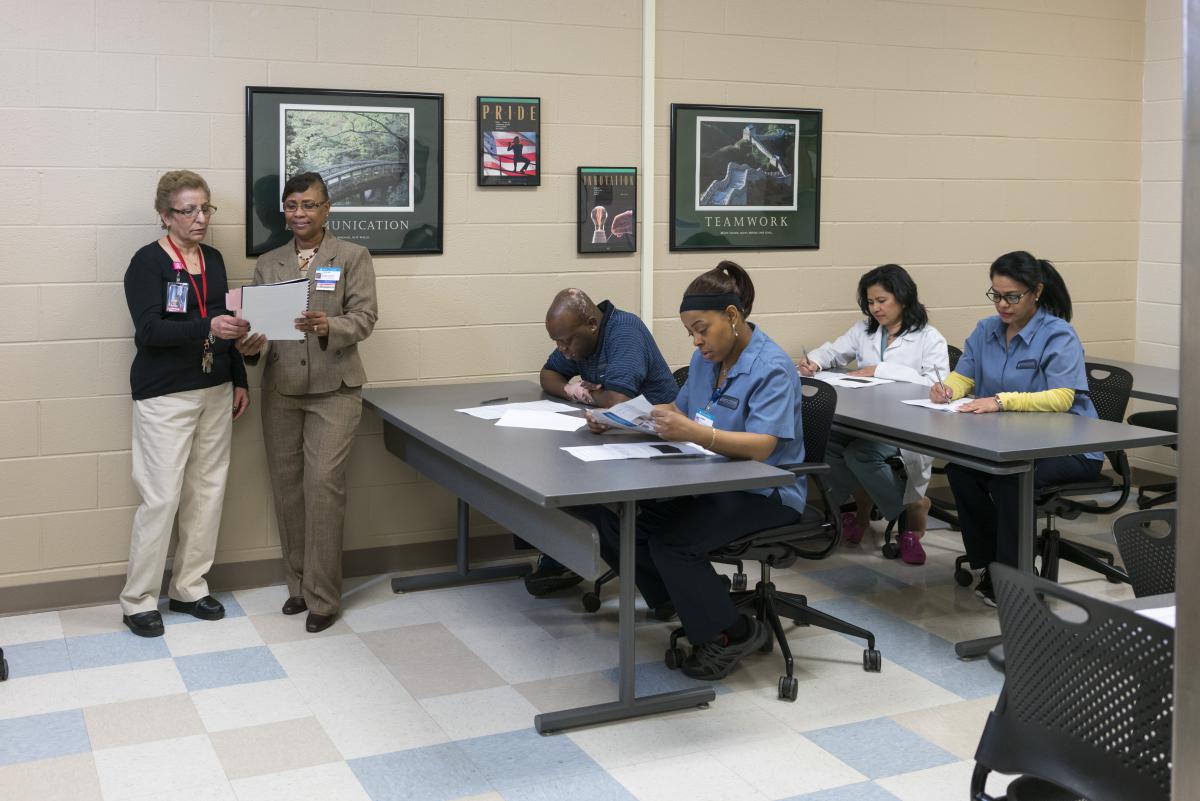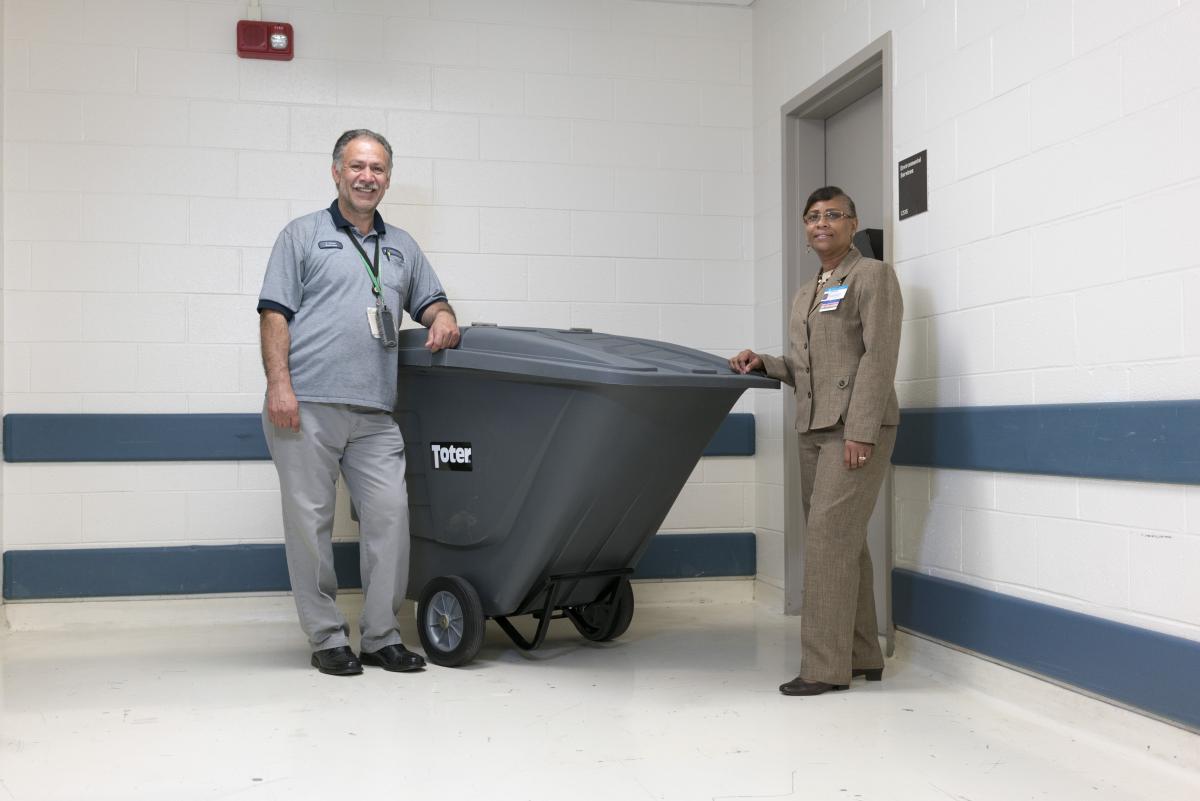A self-proclaimed “fixer,” Charline Gooley, REH, has always loved cleaning. As she tells it, she’d much rather clean than cook, so in her early career as a homemaker, you can bet her floors were so shiny you could see your reflection.
Originally from Memphis, Tenn., Charline moved with her family to the South Side of Chicago as a young girl. After finishing school, she got married and started a family, staying home with her children until her youngest child entered school. It was then that she began her career in the professional cleaning industry at the legendary Marshall Field’s flagship store on State Street in downtown Chicago.
At the time, Marshall Fields wasn’t just a store, it was a destination, particularly during the holidays. Since 1897, the store (now Macy’s State Street) hosted elaborate holiday window displays which extended a full block to tell a story, which attracted visitors from all over the world. Charline started as an entry-level cleaner, pulling trash and wiping down surfaces to keep the marble, glass, handrails and other fixtures clean throughout the building.
While her managers at Marshall Fields immediately saw her potential and quickly promoted her through the ranks, the impact of Charline’s experience in those early years was long-lasting. She started in an entry-level position, which gave her an appreciation for the job that allows her to connect with her staff, even today. She knows just how hard the work can be and understands the challenges her workers may encounter.
“I love to see when things are clean and I love the process of getting it there,” she said. “The industry is a natural fit for me; I love cleaning and working with people to produce that desired result.”



At the time, Charline’s director was Bessie Cooley, a long-time member of IEHA. Even though Charline had an Associate of Arts degree from Daley College in Chicago, Bessie encouraged Charline to join IEHA and pursue her Certification so she could continue to grow in her career. And she did, in 1983.
Cleaning for Health
Charline spent approximately 10 years working at Marshall Fields, and recognized that when you clean in a retail setting, that you’re primarily cleaning to make sure the building looks good. It was through a conversation with a fellow member at an IEHA Chapter meeting that she learned more about the particulars of cleaning in a healthcare setting. The more she learned, the more she wanted to do it—so she made the jump.
“The primary difference about healthcare cleaning is that you’re cleaning to save lives,” said Charline. “The environment in a hospital crosses over everything, so whether a person is sick or healthy, we are cleaning for everyone in the facility.”
Admittedly, she knew very little about nosocomial infections, c-difficile and other healthcare related issues when she began as an Executive Housekeeper, but she was taking IEHA classes with Dr. Bill Joyner, and his hands-on approach to training helped her learn the ins and outs of her new role.
“Cleaning is so important, but there’s no formal degree, which is what makes IEHA’s Certification program so critical. Dr. Joyner was such a great role model during that time. He just knew, and if he didn’t, he would help you get it. I’ll never forget one of his best sayings: ‘You do not expect what you do not inspect.’ It’s something I share with my colleagues to this day.”
Looking to continue growing her skills and knowledge in surgical and psychiatric suites, Charline then went to work for one of the largest hospitals on the west side of Chicago. Around the same time, she completed her Bachelors of Science degree in Healthcare Leadership, committing to her career in the field. Her next move was into the University of Illinois Hospital & Health Sciences System (UI Health), where she currently works, managing a team of more than 100 building services workers and overseeing cleaning operations for the entire medical center, which includes acute and non-acute care services.
“Hospitals move at a much faster pace than retail and there’s more of a sense of urgency in place,” she says. “You are dealing with lives, so it takes a special kind of person to work here.”
A Passion for Training and Development
With a bachelor’s degrees in Health Care Leadership and her REH Certification, training and continuing education is something that Charline considers vital for any professional - and she walks the talk. While she trains her staff for JCAHO and Centers for Medicare and Medicaid Services (CMS) Compliance, she also helps to make sure her staff have access to annual training and career development opportunities.
One such training program is a cultural competency program (see Sidebar 1.1). UI Health is located in a culturally diverse neighborhood and wants to make sure all of its patients and guests feel comfortable during their stay. The cultural competency program is designed to help cleaners understand specific cultural nuances and communicate in a way that makes patients feel more comfortable when they are in their rooms.
When it comes to her own personal development, Charline has maintained an active role in the Chicago Chapter of IEHA, currently serving as the treasurer. While she admits IEHA is a lot different than when she initially joined, she sees great value in the networking resources available.
“Unfortunately, Chapter meetings aren’t as well attended as they used to be because many people don’t make as much time for their personal development,” she said. “Part of this falls on the facilities too—a lot of businesses don’t pay for their employees to grow and stay professionally sharp. But as we move to more online networking, I still feel there’s tremendous value in the opportunities and resources. I know that if I have any type of issue, I can jump onto Unify and ask other members how they’ve overcome similar situations.”
Working Together for a Common Goal
Just as she’s stayed active and networked in the industry, Charline maintains a similar connected role within UI Health. She sits on the infection control team, working closely with infection control prevention professionals to understand emerging issues and develop solutions to keep infections low.
One initiative is a customized high-touch point program that she developed using a tools from the Centers for Disease Control (CDC). It uses a fluorescent gel which is placed on 17 touch points throughout the room. Once the room is cleaned, the supervisor goes back through with a black light to make sure the gel isn’t visible and that the touch points have been cleaned.
“Like with most new initiatives, we received pushback from staff because they thought we were spying on them,” said Charline. “We established a baseline measurement and educated them about what we were trying to achieve. They then understood that we needed evidenced-based data to show how important and effective our work is in creating a clean and healthy environment.”
While cleaning and infection control are central to her responsibilities, she’s also become involved with two new initiatives that impact the hospital’s youngest patients —children and babies—along with their families. The Children’s Hospital University of Illinois (CHUI) has established a Patient & Family Advisory Council (PFAC) to hear and heed “the voice” of its patients and families. She’s also involved with the Newborn Individualized Developmental Care and Assessment Program (NIDCAP). UI is a NIDCAP training center with the goal is to support premature infant’s development. It uses observation of the infant’s behavior to assess when and how they are ready for certain medical care, and promotes overall well-being. Family involvement and understanding of what their infant is telling them through their behavior is a critical part of that, and helping families feel comfortable while in the NICU then helps them interact with their infant in a more natural way, rather than being stressed by the environment.
Her department maintains an active role by making sure the environment is clean, sanitary and healthy for the babies. Recognizing the stress that comes with a sick baby, they work hard to make sure the parents are comfortable from the point they arrive to when they are able to leave with their child.
The Connector
While she considers herself a “fixer,” Charline Gooley is also a connector. She regularly interfaces with physicians, nurses and administrators to help them understand the critical role of her staff in preventing the spread of infection and keeping patient satisfaction scores high.
She’s also regularly working with the individuals on her team. She personally conducts all the new hire orientation, getting to know all the new team members and ensuring they have a clear understanding to perform at a level that the patients expect.
“Our department is a great gateway for individuals who are looking to pursue a career and healthcare and aren’t sure exactly what they want to do,” she said. “If someone is a high performer and wants to further their career in another area of our system, we offer them the resources so they can do just that.”
Outside of the hospital, she’s helping to build bridges and connect a new generation of IEHA members with her vast experience and the knowledge passed down to her and the other students of Dr. William Joyner. As one who has always placed a premium on education and professional development, she feels that IEHA is moving in the right direction.
“I’m looking forward to the new programs IEHA is introducing, such as the Boot Camp Road Show and the Cruise scheduled for 2017,” she said. “In addition, the ‘just in time training/education’ we are doing in the Chapter has been extremely beneficial because it relates to real life situations in which we all face each day in some way.”
Comment by:
Lorrie Tripp
8 years ago (June 3rd, 2016 at 12:16pm)
Thank
0 People thanked Lorrie